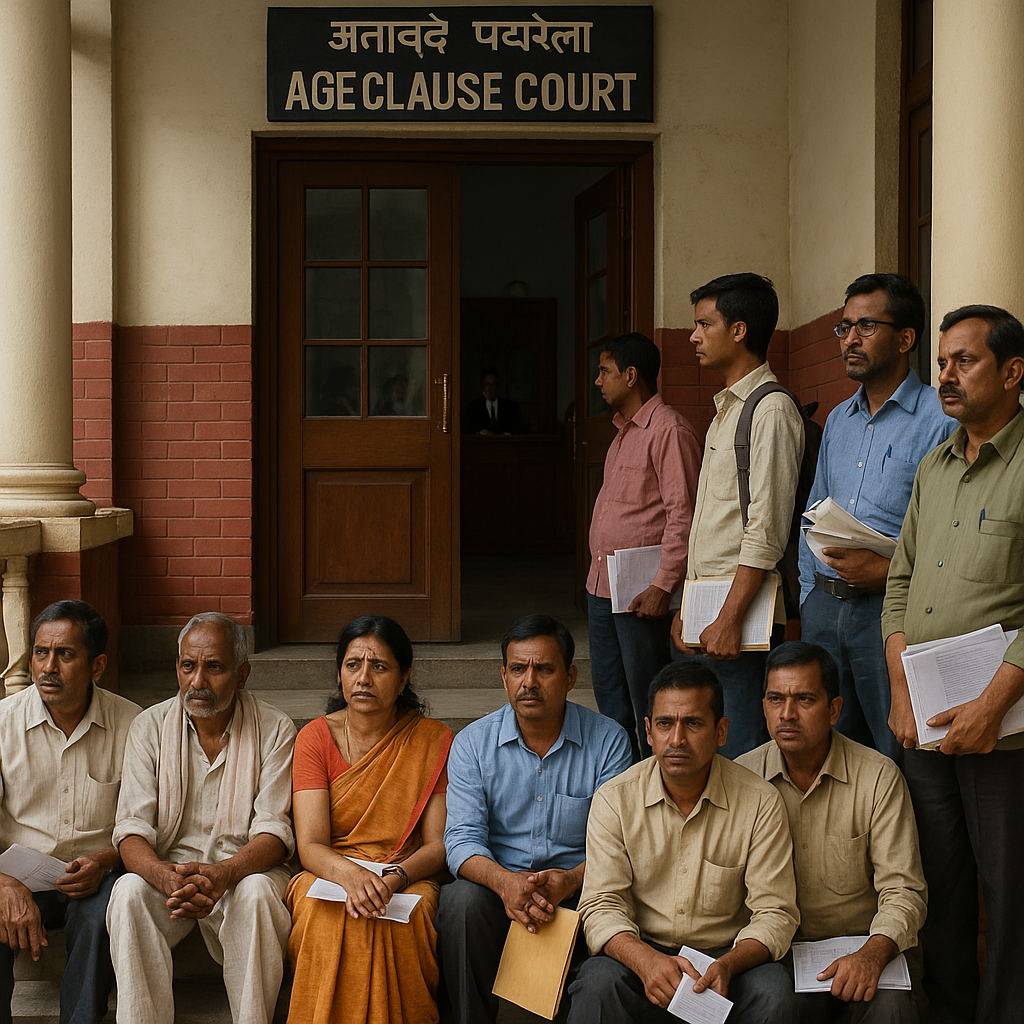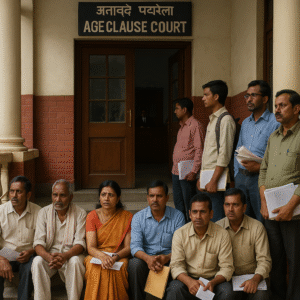The Patna High Court in 2022 dealt with an important procedural question arising out of a long-pending recruitment dispute from East Champaran district. The case began as a service-related writ petition, turned into a contempt proceeding when the recruitment process was delayed, and ultimately reached the Division Bench through a Letters Patent Appeal (LPA No. 1702 of 2019). The appellants were a group of applicants for Class-IV/Group-D posts in the district, and the respondents were officials of the State of Bihar, including the General Administration Department and district-level authorities.
At the heart of the dispute was this grievance: the recruitment process had been initiated late, many applicants had become overage by then, and the High Court in the original writ had said that the State “would consider” age relaxation. When the district authorities completed the recruitment process but did not actually give age relaxation to these candidates, they approached the Court in contempt, saying the authorities had not fully complied with the Court’s earlier order.
However, the learned Single Judge in contempt jurisdiction (in MJC No. 4037 of 2014) took the view that the main direction in the original writ was about completing the recruitment in time, and that if the applicants still had a grievance about non-grant of age relaxation, they should challenge that separately in writ jurisdiction. Instead of filing a fresh writ, the aggrieved applicants filed an intra-court appeal (LPA) against the contempt order.
The Division Bench (Hon’ble Mr. Justice Ashutosh Kumar and Hon’ble Mr. Justice Nawneet Kumar Pandey) examined whether such an appeal was maintainable and what was the correct remedy for aggrieved applicants whose request for age relaxation was not accepted. After hearing both sides, the Bench permitted the appellants to withdraw the appeal so that they could pursue the correct remedy before the appropriate forum, but in doing so, the Court clarified some important principles about how contempt orders can (and cannot) be challenged.
Simplified Explanation of the Judgment
The original writ petition (CWJC No. 1807 of 2014) had one basic direction: the District Magistrate, East Champaran, should complete the recruitment process for the posts that had already been advertised, and appointments should be made from the panel within six months. The Single Judge also made an observation that since the advertisement was being issued after a long gap (after 2002), the State “would consider” relaxing the age of eligible applicants “in accordance with law.” This was an enabling, not a mandatory, direction. It did not by itself grant age relaxation; it only required the State to consider it.
According to the appellants, when the appointments were finally made, they were not given age relaxation, and some of them were left out. So they filed a contempt case (MJC No. 4037 of 2014) saying that the order of the Court had not been fully complied with. The contempt court, however, noted that the main grievance in the contempt petition was only about delay — that appointments were made beyond the six months’ time. It also noted that the petitioners did not clearly raise the plea of non-grant of age relaxation in the contempt proceeding itself. In other words, the ground they later tried to take in appeal was not the ground they had properly urged before the contempt court.
When the matter came before the Division Bench in LPA, counsel for the appellants tried to rely on the Supreme Court decision in Midnapore People’s Co-operative Bank Ltd. v. Chunilal Nanda, AIR 2006 SC 2190, to argue that if a court decides something substantive while hearing a contempt matter, then such an order can be challenged in appeal. They also said that a Division Bench of the Patna High Court had earlier entertained such an appeal in LPA No. 343 of 2013 (arising out of MJC No. 930 of 2012), so their LPA should also be held to be maintainable.
The Division Bench carefully distinguished the earlier case. In that older case, the Single Judge, while deciding contempt, had actually gone beyond the original writ and issued fresh substantive directions (for example, directing regularization according to seniority and not category). Because those directions were in the nature of a fresh writ under Article 226, an intra-court appeal was maintainable. That was an exception, not the rule.
In the present case, however, the contempt court had not issued any such fresh or new direction. On the contrary, it had told the aggrieved applicants: if you are unhappy with non-grant of age relaxation, challenge it in a fresh writ petition. That is, the contempt court had pointed out the correct procedural route.
The Division Bench agreed with that approach. It said that where the grievance is about non-consideration or rejection of a claim (like age relaxation), the proper remedy is to file a substantive writ petition under Article 226 of the Constitution, not to file an LPA against an order passed in contempt jurisdiction. The Bench therefore did not accept the argument that this particular LPA was maintainable. Instead, after the Bench dictated its view, counsel for the appellants sought permission to withdraw the appeal so that the applicants could pursue their grievance before the proper forum. The Court allowed the withdrawal and dismissed the LPA as withdrawn.
So, in plain language:
- The High Court had earlier said: complete recruitment and consider age relaxation.
- The authorities completed recruitment but seemingly did not grant age relaxation to these applicants.
- The applicants chose the wrong route (contempt and then LPA).
- The Division Bench said: the right route is to file a writ directly challenging the denial of age relaxation.
- The appeal was, therefore, not entertained on merits and was dismissed as withdrawn.
Significance or Implication of the Judgment
- Clarity on procedure: The ruling reminds litigants that contempt jurisdiction is meant to secure compliance with a court’s order, not to enlarge, modify, or re-litigate the original dispute. If an authority “considers” a matter but decides against the applicant, that becomes a fresh cause of action for writ, not contempt.
- Recruitment disputes in Bihar: Many district-level recruitments in Bihar get delayed, and candidates become overage. This judgment is a reminder that even if the court says “consider age relaxation,” the candidate may still have to challenge a negative decision separately.
- No shortcut through appeal: Parties cannot use an LPA against a simple contempt order to bypass the statutory and constitutional scheme. Only where the contempt court itself decides a fresh right or gives a new writ-like direction, can an intra-court appeal be said to be maintainable.
- Guidance to government authorities: When the court says “consider,” the authority must pass a reasoned, lawful order. Otherwise, it will be exposed to challenge in writ. This encourages administrative fairness.
- Access to proper forum: The Court here did not shut the door on the applicants. It simply sent them to the correct door — Article 226 — instead of allowing them to press a technically weak appeal.
Legal Issue(s) Decided and the Court’s Decision with Reasoning
- Whether an intra-court appeal (LPA) is maintainable against an order passed in contempt jurisdiction when the contempt court has not issued any new substantive direction?
- Decision: No. Such an appeal is ordinarily not maintainable. The precedent of entertaining such an appeal applies only when the contempt court, in substance, exercises writ jurisdiction and creates new rights or directions.
- What is the correct remedy when candidates allege that age relaxation, which the Court said should be “considered,” has actually been refused or not granted?
- Decision: The correct remedy is to file a fresh writ petition challenging the non-consideration/refusal, not to invoke contempt appeal. The contempt court was right in saying so, and the Division Bench endorsed that view.
- Whether the appellants could be rendered remediless?
- Decision: No. Following the principle in Midnapore People’s Coop. Bank Ltd. v. Chunilal Nanda, a party is not to be left without remedy, but the remedy must be availed in the correct forum. Here, that forum was writ jurisdiction, not LPA.
Judgments Referred by Parties (with citations)
- Midnapore People’s Co-operative Bank Ltd. v. Chunilal Nanda, AIR 2006 SC 2190.
- Patna High Court, LPA No. 343 of 2013, arising out of MJC No. 930 of 2012 (Division Bench decision relied upon to argue maintainability). (Exact reporter citation to be added manually.)
Judgments Relied Upon or Cited by Court (with citations)
- Midnapore People’s Co-operative Bank Ltd. v. Chunilal Nanda, AIR 2006 SC 2190 — for the proposition that where the contempt court issues substantive directions, an appeal may lie, and also that a litigant should not be left without remedy.
- Patna High Court, LPA No. 343 of 2013 (arising from MJC No. 930 of 2012) — distinguished by the Division Bench as a contextual decision because, in that case, the contempt court had issued fresh directions in the nature of Article 226. (Citation to be added manually.)
Case Title
Letters Patent Appeal arising out of Miscellaneous Jurisdiction Case concerning recruitment to district-level posts in East Champaran, Bihar (applicants for Group-D posts vs. State of Bihar and district authorities).
Case Number
- L.P.A. No. 1702 of 2019
- in M.J.C. No. 4037 of 2014
- arising out of C.W.J.C. No. 1807 of 2014
Citation(s)
2023 (1) PLJR 3
Coram and Names of Judges
- Hon’ble Mr. Justice Ashutosh Kumar
- Hon’ble Mr. Justice Nawneet Kumar Pandey
Names of Advocates and who they appeared for
- For the appellants (writ applicants): Mr. Murari Narain Chaudhary, Advocate; Mr. Vijay Kumar, Advocate.
- For the State/respondents: Mr. Prabhat Kumar Verma, AAG 3; (also heard: Mr. Sanjay Kumar Ghosarwe for the State as recorded in the oral judgment).
Link to Judgment
MyMxNzAyIzIwMTkjMSNO-b5t0ZetzrGo=
If you found this explanation helpful and wish to stay informed about how legal developments may affect your rights in Bihar, you may consider following Samvida Law Associates for more updates.








